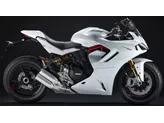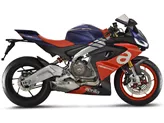Yamaha YZF-R6 2019 vs. Ducati SuperSport 950 S 2021

Yamaha YZF-R6 2019

Ducati SuperSport 950 S 2021
Overview - Yamaha YZF-R6 2019 vs Ducati SuperSport 950 S 2021
When comparing the Yamaha YZF-R6 2019 and the Ducati SuperSport 950 S 2021, there are several notable differences and similarities between the two models.
Starting with the engine and drive train, the Yamaha YZF-R6 2019 features an in-line engine with a displacement of 599cc, producing 118 horsepower and 65.7 Nm of torque. It has a compression ratio of 13.1 and is equipped with a DOHC valve system. On the other hand, the Ducati SuperSport 950 S 2021 has a V-type engine with a displacement of 937cc, producing 110 horsepower and 93 Nm of torque. It has a slightly lower compression ratio of 12.6 and features a Desmodromic valve system. Both models have four cylinders and four valves per cylinder.
In terms of suspension, both models feature upside-down telescopic forks at the front and a monoshock suspension at the rear. However, the Ducati SuperSport 950 S 2021 has a larger front fork diameter of 48mm compared to the 43mm diameter of the Yamaha YZF-R6 2019. Both models offer adjustable compression, preload, and rebound settings for the front and rear suspension.

Yamaha YZF-R6 2019
When it comes to the chassis, the Yamaha YZF-R6 2019 features an aluminum Deltabox frame, while the Ducati SuperSport 950 S 2021 has a steel tubular frame. Both models have a rake of 66 degrees and a trail measurement, with the Ducati having a slightly shorter trail of 91mm compared to the 97mm of the Yamaha.
In terms of brakes, both models are equipped with double disk brakes at the front with a diameter of 320mm. However, the Ducati SuperSport 950 S 2021 features radial and monoblock technology, which provides enhanced braking performance compared to the Yamaha YZF-R6 2019. Both models have hydraulic actuation for the brakes.
When it comes to advanced rider assistance systems, both models offer ABS, riding modes, and traction control. However, the Ducati SuperSport 950 S 2021 also features cornering ABS, ride by wire, a quickshifter, and additional riding modes compared to the Yamaha YZF-R6 2019.
In terms of dimensions and weights, the Yamaha YZF-R6 2019 has a wheelbase of 1375mm, a seat height of 850mm, and a kerb weight of 190kg with ABS. It has a fuel tank capacity of 17 liters. On the other hand, the Ducati SuperSport 950 S 2021 has a longer wheelbase of 1478mm, a lower seat height of 810mm, and a higher kerb weight of 210kg with ABS. It has a slightly smaller fuel tank capacity of 16 liters.

Ducati SuperSport 950 S 2021
In terms of strengths, the Yamaha YZF-R6 2019 is praised for its top chassis, powerful brakes derived from the YZF-R1, sharp design, modern LED lighting system, mature electronics package, easy-to-read display interface, and a rev-happy engine. On the other hand, the Ducati SuperSport 950 S 2021 is praised for its powerful engine, high-quality chassis components, electronics package, sporty design, everyday usability, and low stationary noise level.
In terms of weaknesses, the Yamaha YZF-R6 2019 is noted to have a lack of mid-range punch in the engine and a higher price compared to its competitors. The Ducati SuperSport 950 S 2021 is mentioned to have load vibrations in the lower speed range.
Overall, both the Yamaha YZF-R6 2019 and the Ducati SuperSport 950 S 2021 offer impressive performance and features in their respective categories. The choice between the two models ultimately depends on individual preferences and priorities.
Technical Specifications Yamaha YZF-R6 2019 compared to Ducati SuperSport 950 S 2021
Pros and Cons in comparison
Pros and Cons in comparison
Yamaha YZF-R6 2019

It almost seems as if the Yamaha YZF-R6 was born on the race track. It is easy to see that the R6 is the little sister of the YZF-R1. Whether it's the design, the ergonomics, the braking or the electronic aids - the racing genes are everywhere! The R6 is an outstanding piece of engineering in the 600cc class and, depending on your preferences, is probably the best 600cc bike currently available - at least for the racetrack. The Yamaha gives the rider unbelievably high precision and feedback over the front wheel and the chassis, and is super manageable at the same time! The engine is extremely rev-happy, but also wants to be kept happy. It is a pity that the latest version of the R6 has lost some of its power due to Euro 4... Nevertheless, it will be the faster track bike for most of us. And if there is a need, an open exhaust system (without road homologation) and mapping can tickle a few more horsepower out of the super sports bike. Sharp design meets even sharper components - TOP!
Ducati SuperSport 950 S 2021

Despite its sportiness, Ducati's redesigned and equipped Supersport 950 /S offers a good degree of suitability for everyday use and sufficient power for the country road or occasional trackdays. If you want to remedy the last remaining shortcoming, the throttle response in the lower rev range, which is characterised by load changes, you could consider changing the secondary gear ratio from 15/43 to 14/43. The one-tooth smaller drive pinion costs only a few euros, improves throttle response at low revs and also keeps handlebar and mirror vibrations within acceptable limits.
Price Comparison Avarage Market Price Yamaha YZF-R6 vs Ducati SuperSport 950 S
There are a few key differences between a Yamaha YZF-R6 2019 and a Ducati SuperSport 950 S 2021. It takes less time to sell a Ducati SuperSport 950 S with 93 days compared to 140 days for the Yamaha YZF-R6. Since model year 2005 1000PS.de editors have written 33 reviews for the Yamaha YZF-R6 and 5 reviews for the Ducati SuperSport 950 S since model year 2021. The first review for the Yamaha YZF-R6 was published on 10/17/2002 and now has more than 3,600 views. This compares to more than 45,900 views for the first review on Ducati SuperSport 950 S published on 11/13/2020.




















